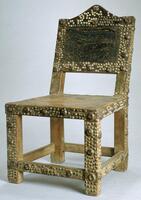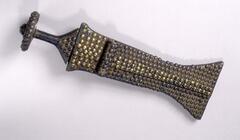109 UMMA Objects
109 UMMA Objects
![This stone dagger has a handle that is divided into two parts, separated from each other by a thinner band. The upper tier is smaller in length than the lower tier, which flares outward as it approaches the end. The tip of blade is broken off. In profile, the blade thickens in the center.<br />
<br />
Carved from stone, this dagger with a two-tier handle is missing only its tip. The cross section of the blade is rhomboid, while that of the handle is shaped like a convex lens. The dagger is of the later two-tier-handled type (<em>idanbyeongsik</em>), meaning that it probably dates from the end of the early Bronze Age or the beginning of the middle Bronze Age. Max Loehr (1903- 1988) was a German art historian specializing in East Asian art who taught at the University of Michigan from 1951 to 1960 as a professor.<br />
[Korean Collection, University of Michigan Museum of Art (2017) p.32] This stone dagger has a handle that is divided into two parts, separated from each other by a thinner band. The upper tier is smaller in length than the lower tier, which flares outward as it approaches the end. The tip of blade is broken off. In profile, the blade thickens in the center.<br />
<br />
Carved from stone, this dagger with a two-tier handle is missing only its tip. The cross section of the blade is rhomboid, while that of the handle is shaped like a convex lens. The dagger is of the later two-tier-handled type (<em>idanbyeongsik</em>), meaning that it probably dates from the end of the early Bronze Age or the beginning of the middle Bronze Age. Max Loehr (1903- 1988) was a German art historian specializing in East Asian art who taught at the University of Michigan from 1951 to 1960 as a professor.<br />
[Korean Collection, University of Michigan Museum of Art (2017) p.32]](/media/W1siZiIsIjIwMjIvMDUvMjUvMjhpaWV3MzJmbV9kZWZhdWx0LmpwZyJdLFsicCIsInRodW1iIiwiMjQweDIwMCJdXQ?sha=d2502c4cf43f3c8e)
Korean (Korean (culture or style))
Polished Stone Dagger
900 BCE – 701 BCE
Museum purchase from the collection of Max Loehr
1960/2.117
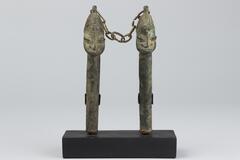
Yoruba (Yoruba (culture or style))
Pair of Staffs
20th century
Gift of Dr. James and Vivian Curtis
1997/1.336
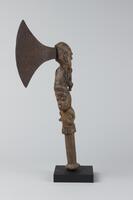
Yoruba (Yoruba (culture or style))
Ceremonial Axe
20th century
Gift of Susan B. and John F. Ullrich
1998/1.53
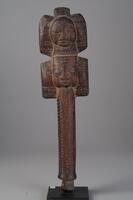
Yoruba (Yoruba (culture or style))
Dance Staff
1950 – 1999
Gift and partial purchase from the estate of Kurt Delbanco in honor of Nicholas Delbanco
2017/1.614

Japanese (Japanese (culture or style))
Portable tea ceremony set - whisk case
1850 – 1900
Gift of Ulrich and Sarah Straus
2013/2.82D

Japanese (Japanese (culture or style))
Portable tea ceremony set - tea scoop (chashaku) bag
1850 – 1899
Gift of Ulrich and Sarah Straus
2013/2.82N
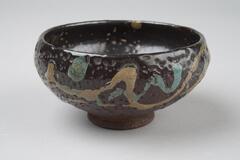
Japanese (Japanese (culture or style))
Portable tea ceremony set - tea bowl
1850 – 1899
Gift of Ulrich and Sarah Straus
2013/2.82Q
Loading…
